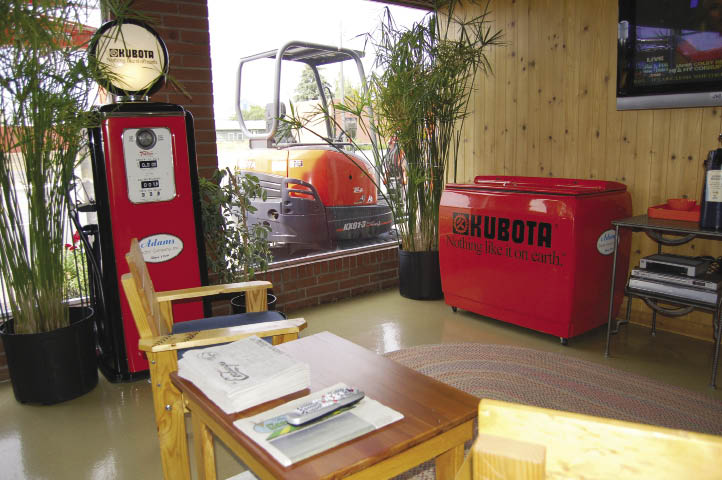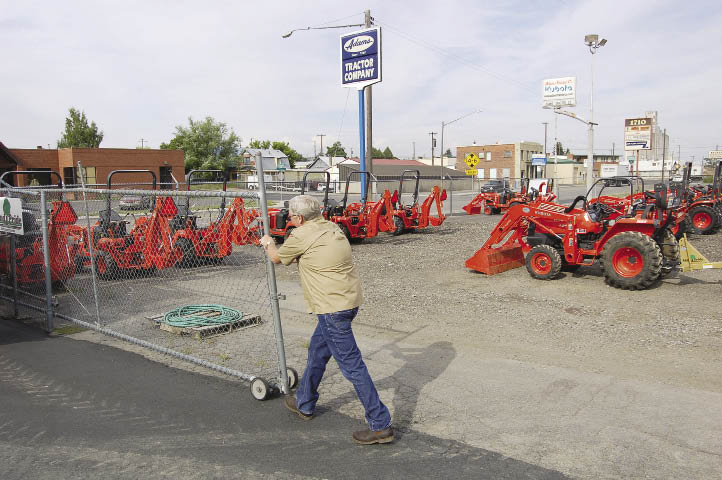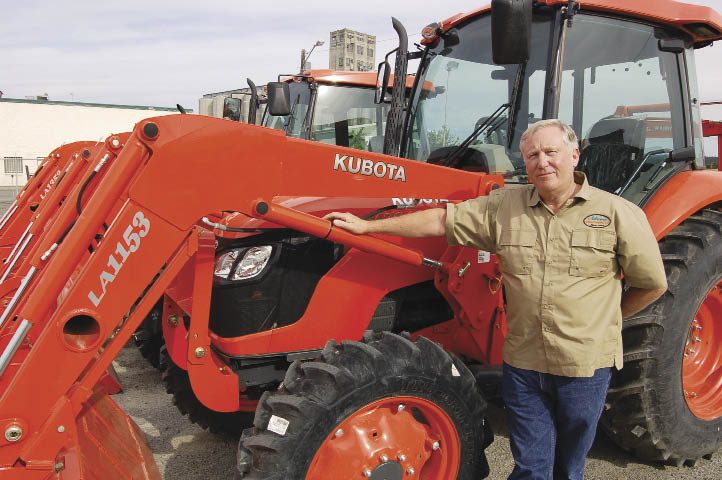With his dealership nearly broke and creditors nipping at his heels, Ken Adams could have walked away from Adams Tractor Co. and moved on with his life.
But he didn’t quit. Only after Adams cut ties with a major supplier and rewrote his business plan did Adams Tractor become what it is today — a thriving Kubota dealership.
The 81-year-old business is reaching out to the growing rural lifestyle market in eastern Washington and fine-tuning its equipment lineup to take further advantage. The dealership had $5.9 million in sales last year and $8.3 million in ’08.
“Going from big to small has been very good for us,” says Adams, who became president of the company in 1985 after starting out several years earlier on the shipping dock. “People say, ‘Ken, you’re brilliant.’ I just tell them that I had to figure out a way to make it better.”
A Small World
The events that led to the founding of Adams Tractor began in 1926. Ken’s grandfather, Donald Adams, was loading a crop of apples onto fruit express cars in Spokane when he was approached by two men who wanted a couple of boxes.
ADAMS TRACTOR CO.
Location: Spokane, Wash.
Founded: 1929
Employees: 15
Major line: Kubota
Shortlines: Billy Goat, Land Pride, Hustler, Kanlan, Kawasaki, Scag, Stihl
Sales: $5.9 million (2009), $8.3 million (2008), $7.1 million (2007)
As they completed their deal and exchanged names and addresses, Don Adams was surprised to find he was doing business with Henry Ford and his son, Edsel. The meeting led to a long association between Adams Tractor and Ford’s product lines. In 1929, a Ford dealer that Don worked for in Spokane decided to discontinue the tractor line, and Don formed Adams Tractor Co.
The Adams family has long been involved in equipment dealerships. At one time or another, all 9 of Don Adams’ children worked at the Spokane location, and currently, 6 of Don’s sons — as well as grandchildren and great-grandchildren — are active in their own dealerships in Washington and Idaho.
Developing Markets
Adams Tractor built its success in the 1940s and ’50s selling New Holland balers and manure spreaders to dairy and cattle farmers, as well as smaller Ford tractors used on small vegetable farms in the area.
As agriculture and customer needs changed, Adams Tractor found itself needing to develop markets for many of its equipment lines in the coming decades.
Dealer Takeaways
• To acquire more municipal customers, be persistent and think about demos.
• If times get tough, get in front of the problem and communicate with your suppliers and banks.
• Evaluate your equipment focus and whether it's keeping new customers away.
A crucial decision had to be made in the mid-1970s when the Ford 8N tractors in their market began wearing out. The dealership picked up the Kubota tractor line, hoping it would complement its New Holland equipment lineup. The Adamses felt Kubota had a future because it would meet the needs of customers moving to the country and desiring a smaller tractor.
At the time, most dealerships probably didn’t realize how big the rural lifestyle market would become, Ken Adams says. “My uncle said if I could sell 12-15 of these a year, he would be really tickled. That first year I sold 45, so he was really tickled.
“It turned out to be a very good decision for us. It was a little scary at the time, but it worked out fine.”
Time to Diversify
In the early 1980s, the cattle and dairy operations Adams Tractor had served for so long started to disappear, forcing the dealership to continue looking in different directions for new customers.
“We needed to diversify. We weren’t selling as much hay equipment, and it was getting pretty competitive,” Adams says.
The dealership picked up Hustler mowers in 1988 and pursued municipal and commercial turf customers. Persistence was the key to succeeding in that segment, with a lot of “towing and showing” to get attention.
Persistence is still the key, Adams says, even if it takes years to land a key customer.
“Municipal people have a habit of finding somebody to do business with and then they

A clean, modern waiting area with a flat-screen TV and a soda machine greets rural lifestyle customers at Adams Tractor Co.’s remodeled showroom.
get into a rut. You send them a mailer and it just ends up in the garbage. If you call them on the phone, they just say ‘no,’ ” he says. “But when you go out and hunt them down, and have the equipment with you, it’s hard for them to turn and walk away. Then you have to just go out and earn their business.”
Today, municipalities and landscape contractors are 15-20% of Adams Tractor’s business and the major clients include Gonzaga Univ. and a private contractor that does outdoor maintenance for nearby Fairchild Air Force Base. This contractor is the dealership’s largest wholegoods and parts customer.
Adams Tractor has sales people dedicated to calling on construction and turf prospects and navigating the governmental bid process. Adams often reminds them that if a key sales opportunity slips away, it could be gone for a long time.
Once the dealership gets a municipality as a customer, the secret to keeping them is “just really good service,” Adams says. “When their equipment break down, you must get them fixed as quickly as you can. And you must treat them fairly.”
Scrambling to Survive
In the mid-1990s, a litany of supplier issues, market changes and financial problems took a toll on the dealership.
Ford acquired New Holland, which was bought by Fiat, and Adams says the corporate changes and other issues strained the relationship with New Holland. In addition, “Our customer base was shrinking, and we had to go further out to gain market share.”
Federal audits of the dealership’s 401K and ESOP programs caused a lot of internal strife, and in August 1999, the problems came to a head. His primary bank wouldn’t loan him more money, and he was sold out of trust with both New Holland and Kubota. Adams’ accountant advised him to shut the doors.
“Essentially, we were broke. We just couldn’t feed the big machine any more. Kubota had been growing, but we had put our emphasis on haying,” Adams recalls. “We were sitting at the table trying to figure out how to make this work. My dad was looking out the door and saying, ‘I just can’t believe at 70 years we’re going down the tubes for $400,000.’ I said, ‘Dad, we’re going to figure something out.’ ”
Ken reassured the banks and suppliers that he was coming up with a reorganization plan. The first step was sitting down and “figuring out how to cut overhead and make it work,” Adams says.
Six months later, he took a new business plan to his cousin’s accountant. “Looking at your numbers, you’re telling me you will have to increase sales by $2 million a year, increase your gross margin to 22% and cut expenses by 3%. Can you do that?” Ken recalls the accountant asking him. Adams’ answer was “no.”
A Major Change
That’s when Adams decided a bigger change was needed to get the dealership on the right track.
He decided it was time to end his relationship with New Holland and focus on selling Kubota equipment.
“So I got the yellow pad of paper out, we sold the parts back to pay off the equipment that was sold out of trust, so we could be clean with New Holland.” The family forecast its financials for the next 5 years with New Holland no longer in the picture, going through each budget line thoroughly to make sure it would work, and their accountant approved of the plan.
Through this streamlining, “We could see the new look of Adams Tractor,” Adams says.
A New Beginning
As Adams Tractor adjusted to life with only one mainline supplier, Adams noticed changes in the real estate market that confirmed that he made the right decision.
Every time a farmer got short on money, they would “go down on the lower 80 and

Ken Adams likes his dealership to order equipment conservatively and avoid getting buried in inventory.
kick out a couple of 10-acre parcels out, and every time he kicks out a couple of parcels, those people come in to buy Kubota tractors from us,” Adams says.
The last year that Adams Tractor carried New Holland equipment, about 70 Kubota tractors were sold. The following year, it was 105, and the total grew every year until 2009.
“This Kubota thing was starting to look pretty good. We’re generating some cash, we sold some property, paid some bills, decreased overhead, and our Kubota business is starting to grow. Without having the big swathers and balers out there, and by changing our advertising, we’re seeing more of the weekend warriors coming in.
“It dawned on me that we were so busy trying to serve the hay guys that we weren’t serving the rural lifestyle guys.” This convinced Adams to take more action. “We remodeled the showroom, put in a flat-screen TV, put a pop machine in, changed our advertising, got the tire chains out of one corner and the old farm jack out of the other corner and cleaned the place up.
“And now we paint and keep it clean, and the janitor comes in twice a week. We attract that type of person now. We have people who come in from other places and say, ‘We couldn’t get anyone to talk to us. There were 10 people at the parts counter and we didn’t feel very welcome.’ ”
Gaining New Customers
Getting out of the hay business has handicapped Adams on selling the higher-horsepower tractors, but the dealership is doing more business with horse farms, large-property owners and hobby farmers raising vegetables, pumpkins or other crops.
He estimates 75% of his business now is the weekend warrior. “The guy who buys a BX model from us is every bit as important as a guy who buys an M135. For some guys, it’s therapy for them. We have a doctor who specialized in cancer treatment and his hobby farm consists of fences. He takes his L3750 Kubota that I sold to him 35 years ago and he builds fences.”
So how do you keep rural lifestylers happy? “You have to gain their confidence and give them the service and care they need,” Adams says.
Here’s one example: On a recent morning, a female customer called because she couldn’t remove the snowthrower from the tractor she bought at the dealership. Adams happened to be on the road and stopped by to swap out the snowthrower for a loader and put a tiller on the back.
Adams didn’t charge her for that visit, or for the time he spent on the phone later explaining a nuance on operating the tiller. “We do a lot of that, and it costs money to do that,” he says, “but she’ll tell her neighbor how she was well taken care of.”
Watching Inventory
The dealership turns inventory 2 times a year, “which within 6-9 month flooring is not bad,” Adams says. The dealership takes advantage of both planned and regular buying, Jack Walker, sales manager, is responsible for keeping inventory balanced.
“I think Kubota would like us to order more, but we’re trying to be conservative. We would rather take a shorter flooring term and control our inventory than to get buried in inventory for 3 more months,” Adams says.
“If you overstock, you put yourself into a death spiral. The payments start to come due, so you reduce your margin, which reduces your profit, which reduces your cash flow, which reduces your ability to pay your people and your bills. It just doesn’t work.
“My dad always told me when floorplanned equipment gets to be interest bearing, sell it for what you can get and put it into something that you can sell. During the 1990s, I tried the practice of losing a little bit of money on every deal and making it up on margins in hay equipment, and it doesn’t work. I proved that it doesn’t work.”
Picking Shortlines
A benefit of having chosen strong shortline suppliers many years ago is that Adams Tractor hasn’t had to constantly change them to keep customers happy. The Hustler and Billy Goat brands have been on his lot for many years.
But that hasn’t stopped the dealership from taking advantage of good opportunities. Last October, Adams signed an agreement with Canada-based Kanlan Attachments, which makes front-mounted winter snow removal and spring cleanup attachments for compact articulating tractors, utility tractors and utility vehicles.
And a big break came recently when Adams Tractor became an authorized full-service Stihl dealership. Adams said he waited nearly a decade for Stihl sales territory to open up, and he quickly renovated a back storage room into a small engine repair shop so he could both sell and repair the equipment.
The dealership expects to sell 250 pieces of Stihl equipment in 2010, compared to the previous supplier that attracted 50 sales last year — mostly in string trimmers, blowers and hedge trimmers.
Adams says he’s already selling 2 or 3 Stihl pieces and fixing 5-6 more each week, so the move is already paying off. “When someone goes out and they’re busy with 5, 10, 15 acres, the first two things they think about are a chain saw and a tractor. And when people think of chain saws, they think of Stihl.”
When he evaluates whether to add a shortline at the dealership, Adams’ main criteria is whether or not he can reach $100,000 in unit sales annually, or whether the new brand complements the current lineup. He thought about adding a lower-cost line of tractors to go after another market niche, but he didn’t see a price gap that was large enough.
The dealership tried bringing in a line of low-priced attachments “and it was a disaster,” he says. “You’ve got $695 and $395 posthole diggers. You sell the $695 one to a guy and he takes it home and it digs holes. You sell the $395 one to him and he takes it home and it breaks. And when you come to work on Monday he’s here, and he’s unhappy and he wants to know why it broke.
“So then you fix it and you don’t get reimbursed for fixing it or investing the time, and you’ve got an angry customer. We’d had rotary cutters and posthole diggers blowing up on us, so we got rid of them. With Land Pride, you put their rotary cutter on the back of his truck and he’s happy as hell.
“Land Pride suits Kubota, and it was sweet for us when they did a strategic alliance. But you should try to pick lines carefully and hold on to them, and continue with them so you have more consistency in parts and service.”
Bolstering Service
One area Adams Tractor would like to improve is increasing service revenue. Customers in the Spokane area put 50-100 hours a year on their tractors, so they don’t get worn out very fast “unless they do the boo-boo,” Adams says.
“We’ve had guys fall trees across the hoods of their tractors, and they’ve rolled them down hills. We had a doctor put a BX24 tractor in a swimming pool. Otherwise, they’re just not wearing a lot of stuff out.”
Adams brought Kubota excavators back onto the lot in hopes of improving service profit. Adams Tractor has a full-blown mobile service truck that’s used 3 days a week, and the dealership’s goal is to use it 5 days a week.
“There will be some challenges there. Kubota doesn’t understand the concept of 50-100 tractor hours a year. The industry says you should be making money on parts and service and the wholegoods is gravy. When you’re a rural lifestyle dealer that doesn’t work. Wholegoods is what pays the bills and parts and service is the gravy.”
The dealership attempts to increase customer traffic another way — by building customer service.
For the first 90 days after a tractor is sold, service technicians will go out to a customer or bring the equipment to the shop, at no charge, to make a repair. Doing so not only shows commitment on the dealership’s part but saves a ton of callbacks after the fact, Adams says.
Tractors don’t get delivered without an owner’s manual, and the delivery driver “will spend as much time as the customer needs in getting familiar with how it works, or how the loader comes off and goes on,” he adds. “With some people it takes 20 minutes, some it takes 3 hours.”
A final piece of the service puzzle for Adams Tractor will be having a presence on Facebook and Twitter, although Adams admits that’s “really stepping out of the box” for his dealership. As a starting point, he plans to get every customer’s e-mail address so he can notify them of completed repairs and cut the cost of marketing.
A recent direct-mail service promotion for Stihl products cost Adams Tractor $1,800, “and if I had e-mail I could have done the same thing by hitting the ‘send’ button,” Adams says.






Post a comment
Report Abusive Comment